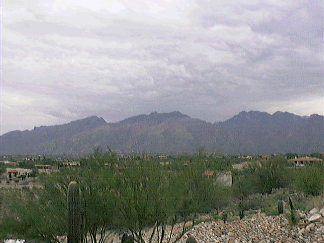|
Entertainment Magazine: Tucson: Santa Catalina Mission Santa Cathalina de Agtun (Actun) #2: East of Santa CruzThis is an excerpt from the book "Treasures of the Santa Catalina Mountains" by Robert E. Zucker. Download a free PDF sample of the book and purchase on Amazon.com.
1727-1741, Santa Catharina marked on a map east of the Santa Cruz. The visita is “seven (leagues) to the east (of San Agustin)” (Hammond, “Pimeria Alta After Kino’s Time,” 1929). Note: 7 leagues measures about 24.1663 miles (a league is 2.7-3.4 miles). 24 miles northeast of San Xavier falls between Cañada del Oro and La Ventana in the Santa Catalinas. The Agtun (also spelled as Actun) location is northeast of San Xavier. A 1737 Spanish document, in possession of the author, confirms this in writing. 1732, Three German priests were sent to the Santa Cruz, San Pedro and “the third Jesuit, Father Phelipe Segesser, took on the task of converting the Pimans of Bac and the down-river rancherías of Tucson, San Agustín and Santa Catarina (ibid., p. 229-230). 1733 the Swiss Jesuit Gaspar Stiger replaced Segesser at Bac” He fell ill with a bacteria four months later and left. (“Tubac Four Centuries, iv, A”) 1734, June 31: Indians revolt at San Xavier, Geuvavi and missions in the area are abandoned. 1736 "Padre Jacobo Sedelmayr wrote that various mines had been discovered near the missions of San Xavier, Santa Maria Soanca and Guevavi." (Source: "Misc. notes AHS file Missions -- Arizona - Guevavi") 1736, Padre Keller held services, conducted baptism for Rojas-Bernabe family at Agtun (Mission Database, 6111) Also returned in 1737, and 1743). Source: US Dept Interior, Father Kino, Frank Pinkley 1736, “Recoverable minerals were found in northern Piman country on a grand scale in 1736.” (Hammond 1929:237-238). (“Tubac through the Centuries,” Dobyns) 1737, Aug 13: Ignacio Xavier Keller is visiting priest at Santa Catalina de Agtun. Baptism of 52 people (Mission Database 2000, #6118) 1743, Keller is visiting priest at Sta C. (Source: US Dept Interior, Father Kino, Frank Pinkley) 1748, missionaries baptized children from Aquitini. Not occupied when Spanish scouting party passed through Dec. 27, 1751. No record of reoccupation after revolt, so presumed they absorbed into other settlements after the revolt (Marana Heritage Project). 1751, November 20-21, Pima Indian Revolt uprising- blamed on Keller’s argument with native Luis Oacpicagigua (Luis of Saric). All Pimeria Alta missions abandoned. 1752, March 26-May 25, As part of a plan to refortify the area, Lt. Francisco Xavier de Escalante of the Fronteras garrison, who spent 31 years in the northern frontier since 1720, advocates for building two forts, enclosed with adobe walls, at Tubac and another location in northern Piman: “Father Visitor Jacob Sedelmayr, writing from Ures Mission, joined in advocating two forts, one to be fixed four or five leagues north of San Francisco Xavier del Bac Mission at Tucson or Santa Cathalina, and the other somewhere in the valley extending from Saric and Tubutama to Caborca (Sedelmayr May 10, 1752:102v). “Father Rector Gaspar Stiger replied from San Ignacio Mission that he agreed with Father Visitor Jacobo. If one fort were established, Arizona was the proper place. If two were founded, they should be at Santa Catharina or Tucson and at Ocuca (Stiger 1752:103).” “Father Visitor Philip Segesser replied from his mission at Ures that of course two forts should be founded, one to be placed at the northern Piman village at Tucson or at Santa Cathalina beyond it, and the second at Arisona or Saric. (Segesser May 25, 1752:101v).” “Segesser, who had labored briefly in the San Xavier del Bac Mission of which Tucson and Santa Cathalina where visitas twenty years previously, seconded Sedelmayr's argument for locating one detachment far down the Santa Cruz River.” The Royal Fort of St. Ignacius at Tubac was built and “the council approved the division of the new company into two separate detachments” of 50 soliders and Capt. Don Juan Thomas de Beldarrayn, with swords, lances, powder, cannons and balls at royal expense for the new Upper Pimería Company. (from “Tubac Through Four Centuries,” Henry Dobyns). Escalante witnessed the Pima uprising (Mission Database 2000). Note: 4-5 leagues are about 13.80-17.26 miles. 1753, “The ores Francisco Xavier Padilla had worked in the Santa Rita Mountains prior to the Pima Revolt of 1751 were proved. There is some indication that these deposits were being worked again shortly after the founding of the royal fort at Tubac, for Governor Diego Ortiz Parrilla referred to the "Mineral de la Sierra de Santa Rita" in the fall of 1753 in describing the province for his successor (Ortiz Parrilia Oct. 22, 1753:33). The expression may only have meant that the governor was aware of Padilla's proved ore deposits, however, not that they were being currently worked.” (from “Tubac Through Four Centuries,” Henry Dobyns). |
